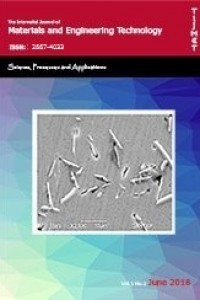EFFECT of GLASS FIBER HYBRIDIZATION on LOW VELOCITY IMPACT BEHAVIORS of BASALT FIBER REINFORCED COMPOSITES LAMINATES
EFFECT of GLASS FIBER HYBRIDIZATION on LOW VELOCITY IMPACT BEHAVIORS of BASALT FIBER REINFORCED COMPOSITES LAMINATES
Basalt fiber, Glass fiber Hybridization, Charpy, Impact energy,
___
- Jarukumjorn, K, & Suppakarn, N, Effect of glass fiber hybridization on properties of sisal fiber–polypropylene composites, Composites Part B: Engineering, 2009, 40(7), 623-627.
- Flynn, J, Amiri, A, & Ulven, C, Hybridized carbon and flax fiber composites for tailored performance, Materials & Design, 2016, 102, 21-29.
- Caminero, MA, Rodríguez, GP, & Muñoz, V, Effect of stacking sequence on Charpy impact and flexural damage behavior of composite laminates, Composite Structures, 2016, 136, 345-357.
- Ghasemnejad, H, Furquan, ASM, & Mason, PJ, Charpy impact damage behaviour of single and multi-delaminated hybrid composite beam structures, Materials & Design, 2010, 31(8), 3653-3660.
- Tarpani, JR, Maluf, O, & Gatti, MCA,Charpy impact toughness of conventional and advanced composite laminates for aircraft construction, Materials Research, 2009, 12(4), 395-403.
- Perry, JL, & Adams, DF, Charpy impact experiments on graphite/epoxy hybrid composites, Composites, 1975, 6(4), 166-172.
- Bozkurt, ÖY, Özbek, Ö, & Abdo, AR, The effects of nanosilica on charpy impact behavior of glass/epoxy fiber reinforced composite laminates. Periodicals of Engineering and Natural Sciences, 2017, 5(3).
- Erkliğ, A, Doğan, NF, & Bulut, M, Charpy impact response of glass fiber reinforced composite with nano graphene enhanced epoxy. Periodicals of Engineering and Natural Sciences, 2017, 5(3).
- Najafi, M, Khalili, SMR, & Eslami-Farsani, R, Hybridization effect of basalt and carbon fibers on impact and flexural properties of phenolic composites, Iranian Polymer Journal, 2014, 23(10), 767-773.
- Bozkurt, ÖY, Erkliğ, A, & Bulut, M, Hybridization effects on charpy impact behavior of basalt/aramid fiber reinforced hybrid composite laminates, Polymer Composites, 2018, 39(2), 467-475.
- Ramesh, M, Palanikumar, K, & Reddy, KH, Mechanical property evaluation of sisal–jute–glass fiber reinforced polyester composites, Composites Part B: Engineering, 2013, 48, 1-9.
- Hong, SW, Ahn, SS, Li, H, Kim, JK, Ko, SJ, Koo, JM, & Seok, CS, Charpy impact fracture characteristics of CFRP composite materials according to variations of fiber array direction and temperature. International Journal of Precision Engineering and Manufacturing, 2013, 14(2), 253-258.
- Morioka, K, & Tomita, Y, Effect of lay-up sequences on mechanical properties and fracture behavior of CFRP laminate composites. Materials Characterization, 2000, 45(2), 125-136.
- Behnia, S, Daghigh, V, Nikbin, K, Fereidoon, A, & Ghorbani, J, Influence of stacking sequence and notch angle on the Charpy impact behavior of hybrid composites. Mechanics of Composite Materials, 2016, 52(4), 489-496.
- ISO, I, 179–1, Plastics—Determination of Charpy Impact Properties, Part 1: Non-Instrumented Impact Test, International Organization for Standardization: Geneva, Switzerland, 2010.
- Yayın Aralığı: Yılda 2 Sayı
- Başlangıç: 2018
- Yayıncı: Necip Fazıl YILMAZ
Özkan ÖZBEK, Ömer Yavuz BOZKURT, Ahmet ERKLİĞ
EFFECT OF SECONDARY AGING of EN AC 43200 ALUMINUM ALLOY to MECHANICAL PROPERTIES
Bedri BAKSAN, İbrahim ÇELİKYÜREK, Yusuf KILIÇ
REMOVAL of DYE POLLUTION by MODIFIED HALLOYSITE as ECO-FRIENDLY ADSORBENT
INVESTIGATION OF THE BULLET IMPACT ENERGY PERFORMANCE ACCORDING TO VARIABLE TIP GEOMETRY
Murat SUBAŞI, Mehmet Hanifi DOĞRU, Eyüp YETER, Necip Fazıl YILMAZ
